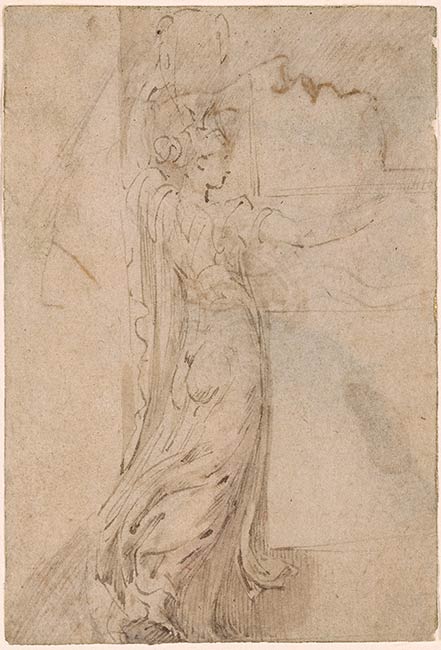

In 1531, Parmigianino was commissioned by the Confraternity of the church of Santa Maria della Steccata, Parma, to decorate the East vault, its archfaces, and the semi-dome of the apse in a period of eighteen months from the drawing up of the contract on the 10 May of that year. Work, however, dragged on for eight years, almost until the end of Parmigianino’s life. Vasari insisted that the artist’s distracting preoccupation with alchemy was to blame, but Parmigianino’s slow working methods and several disputes with the church also intervened.1
The present drawing is one of many studies related to the Steccata commission. Parmigianino depicted three maidens in classical dress at the springing of each side of the vault. The figure on the recto corresponds almost exactly to the Virgin on the left of the North, or right, wall of the vault, although in the drawing she is more attenuated in proportion and drawn with greater delicacy than the more classical, monumental painted figure. Several related drawings survive in which Parmigianino studied the same maiden in isolation.2
It is worth noting that for the ornate and complex decoration of the Steccata, Parmigianino’s most important large-scale commission, the artist drew on successful prototypes by Raphael, Mantegna, Correggio, Perino del Vaga and Giovanni da Udine. As Susan Strauber noted, Parmigianino’s amphora-carrying figures recall the woman with the pitcher of water on her head from the right-side of Raphael’s Fire in the Borgo.3 The figure type is ultimately derived from antique sources, which Adolfo Venturi compared to Tanagra figurines.4
Sydney Freedberg suggested that the head on the verso might be a study for the head of the right canephoros on the south wall of the Steccata.5 Strauber observed, instead, that the area above her head seems to describe a helmet, suggesting the figure represents Minerva.6
Footnotes:
- Vasari 1878-85, 5: 231-22.
- Gnann 2007, 1: 473, nos. 763, 764; 484-85, nos. 830-35
- Providence 1973, 39, no. 40.
- Venturi 1926, 9.2: 663.
- Freedberg 1950, 195.
- Providence 1973, 39, no. 40.
In 1531, Parmigianino was commissioned by the Confraternity of the church of Santa Maria della Steccata, Parma, to decorate the East vault, its archfaces, and the semi-dome of the apse in a period of eighteen months from the drawing up of the contract on the 10 May of that year. Work, however, dragged on for eight years, almost until the end of Parmigianino's life. Vasari insisted that the artist's distracting preoccupation with alchemy was to blame, but Parmigianino's slow working methods and several disputes with the church also intervened.¹
The present drawing is one of many studies related to the Steccata commission. Parmigianino depicted three maidens in classical dress at the springing of each side of the vault. The figure on the recto corresponds almost exactly to the Virgin on the left of the North, or right, wall of the vault, although in the drawing she is more attenuated in proportion and drawn with greater delicacy than the more classical, monumental painted figure. Several related drawings survive in which Parmigianino studied the same maiden in isolation.²
It is worth noting that for the ornate and complex decoration of the Steccata, Parmigianino's most important large-scale commission, the artist drew on successful prototypes by Raphael, Mantegna, Correggio, Perino del Vaga and Giovanni da Udine. As Susan Strauber noted, Parmigianino's amphora-carrying figures recall the woman with the pitcher of water on her head from the right-side of Raphael's Fire in the Borgo.³ The figure type is ultimately derived from antique sources, which Adolfo Venturi compared to Tanagra figurines.⁴
Sydney Freedberg suggested that the head on the verso might be a study for the head of the right canephoros on the south wall of the Steccata.⁵ Strauber observed, instead, that the area above her head seems to describe a helmet, suggesting the figure represents Minerva.⁶
Footnotes: (1) Vasari 1878-85, 5: 231-22. (2) Gnann 2007, 1: 473, nos. 763, 764; 484-85, nos. 830-35. (3) Providence 1973, 39, no. 40. (4) Venturi 1926, 9.2: 663. (5) Freedberg 1950, 195. (6) Providence 1973, 39, no. 40.
Watermark: none.
Dalton, Richard, 1715?-1791, former owner.
Scholz, János, former owner.
Rhoda Eitel-Porter and and John Marciari, Italian Renaissance Drawings at the Morgan Library & Museum, New York, 2019, no. x.
Selected references: Freedberg 1950, 195; Copertini 1952, 121; Fagiolo dell'Arco 1970, 276; Popham 1971, 1: 225-26, no. 789; Providence 1973, 39, no. 40; Washington and New York 1973-74, 71-72, no. 60; Scholz 1976, no. 33B; Battisti 1982, 120; Vaccaro 2002, 189; Gnann 2007, 1: 484-85, no. 832.
Ryskamp, Charles, ed. Twentieth Report to the Fellows of the Pierpont Morgan Library, 1981-1983. New York : Pierpont Morgan Library, 1984, p. 276.
